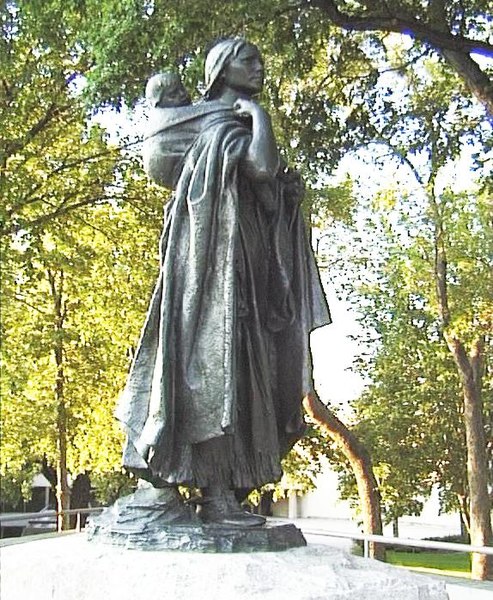Difference between revisions of "Sacagawea and Adoption"
(Created page with "{{#eimage: http://upload.wikimedia.org/wikipedia/commons/thumb/e/ef/Sakakawea-statue-bismarck-nd-2004.jpg/493px-Sakakawea-statue-bismarck-nd-2004.jpg |410x579px|thumb|'''Statu...") |
m (→References) |
||
| (One intermediate revision by the same user not shown) | |||
| Line 14: | Line 14: | ||
Kessler, Donna. The Making of Sacagawea: A Euro-American Legend. (University of [[Alabama]] Press, 1996) | Kessler, Donna. The Making of Sacagawea: A Euro-American Legend. (University of [[Alabama]] Press, 1996) | ||
Howard, Harold P. Sacajawea. (University of [[Oklahoma]] Press, 1971) | Howard, Harold P. Sacajawea. (University of [[Oklahoma]] Press, 1971) | ||
| − | Ogden, Eloise. "Two Graves, Two Sakakaweas." [Includes "Longtime Educator Who Cherished Sakakwea Legacy Dies at 89"]. Minot Daily News, 9 June 1999[?]. Also available at: | + | Ogden, Eloise. "Two Graves, Two Sakakaweas." [Includes "Longtime Educator Who Cherished Sakakwea Legacy Dies at 89"]. Minot Daily News, 9 June 1999[?]. Also available at: www.oweb.com/mionotdaily/text/newsarchive/6999/9sak.htm |
| − | Ogden, Eloise. "Was Sakakawea Shoshone or Hidatsa?" Minot Daily News, 6 May 1999[?]. Also available at: | + | Ogden, Eloise. "Was Sakakawea Shoshone or Hidatsa?" Minot Daily News, 6 May 1999[?]. Also available at: www.oweb.com/mionotdaily/text/newsarchive/5699/6SAKAKWE.htm |
| − | Anderson, Irving W. "Sacajawea? - Sakakawea? - Sacagawea?: Spelling - Pronunciation - Meaning." We Proceeded On, (Summer 1975). Also available at: | + | Anderson, Irving W. "Sacajawea? - Sakakawea? - Sacagawea?: Spelling - Pronunciation - Meaning." We Proceeded On, (Summer 1975). Also available at: www.lewisandclark.org |
| − | "Sacajawea." Available at: | + | "Sacajawea." Available at: kids.infoplease.com/ce5/CE045261.html |
| − | "Sacajawea: Sacajawea - Sakakawea - Sacagawea." Available at: | + | "Sacajawea: Sacajawea - Sakakawea - Sacagawea." Available at: greenfield.fortunecity.com/flamingo/102/sacajawea.html |
[[Category: Adoption Celebrities]] | [[Category: Adoption Celebrities]] | ||
Latest revision as of 04:59, 4 March 2018
Biography
Sacagawea was probably born a Shoshone. When she was about 10-12 years old and probably living in Idaho, she was one of a group of boys and girls, including her brother and sister, who were captured by the Hidatsa people, enslaved, and became acculturated.
When a young woman she was sold on to a French-Canadian trader, Toussaint Charbonneau, who was living with the Mandan and Hidatsa people, and became his wife. When she was about 17 the Lewis and Clark expedition arrived (November 1804) in the district and hired Charbonneau and Sacagawea as guides and interpreters. Sacagawea was then pregnant and gave birth to her first child, Jean Baptiste Charbonneau, at Fort Mandan in 1805, two months before the expedition resumed its way west.
Rather than a mere adjunct to her husband, Sacagawea proved vital to the expedition in negotiating with the Shoshone for the horses necessary to cross the Rocky Mountains, and her and the baby's presence helped keep the tempers of the men cool, as well as reassuring the tribes en route of their peaceful intent. While on the expedition they met her brother, now the Shoshone Chief Jamawaih, and she adopted her elder sister's child. She and Clark's slave were the only expedition members who were never paid for their contributions.
After the expedition she is believed to have left her abusive husband and placed Jean Baptiste with Clark as a foster child in 1811. She died in 1812 at Fort Manuel, South Dakota, and may be buried there. There are numerous natural features, parks and schools named after her, there is a statue of her in the state capitol at Bismarck, ND, and in 1999 a new US silver dollar coin was issued with her portrait.
Many of the facts of her life are disputed. Her given date of birth is only an estimate. She is claimed by both the Hidatsa and Comanche tribes. Some sources state that she was initially captured by the Mandan (who are closely allied with the Hidatsa), or that she was captured by the Hidatsa and sold to the Mandan as a slave. Hidatsa oral history states that she was actually born a Hidatsa, originally captured with her brother Jamawaih and a sister by the Shoshone as a very young girl, and the raid when she was 10-12 simply recaptured her to her own people. Some say she was not bought by Charbonneau but won in a gamble. The most major discrepancy concerns her death: a second version of her life states that she died not aged 25 in South Dakota but in 1884 on the Wind River reservation in Wyoming, where there is a marked grave at Fort Washakie. A third version gives her burial place as north-west North Dakota.
References
Kessler, Donna. The Making of Sacagawea: A Euro-American Legend. (University of Alabama Press, 1996) Howard, Harold P. Sacajawea. (University of Oklahoma Press, 1971) Ogden, Eloise. "Two Graves, Two Sakakaweas." [Includes "Longtime Educator Who Cherished Sakakwea Legacy Dies at 89"]. Minot Daily News, 9 June 1999[?]. Also available at: www.oweb.com/mionotdaily/text/newsarchive/6999/9sak.htm Ogden, Eloise. "Was Sakakawea Shoshone or Hidatsa?" Minot Daily News, 6 May 1999[?]. Also available at: www.oweb.com/mionotdaily/text/newsarchive/5699/6SAKAKWE.htm Anderson, Irving W. "Sacajawea? - Sakakawea? - Sacagawea?: Spelling - Pronunciation - Meaning." We Proceeded On, (Summer 1975). Also available at: www.lewisandclark.org "Sacajawea." Available at: kids.infoplease.com/ce5/CE045261.html "Sacajawea: Sacajawea - Sakakawea - Sacagawea." Available at: greenfield.fortunecity.com/flamingo/102/sacajawea.html
- Adoption Celebrities
- Adopted Persons
- Native American and Alaskan Native, Inuit
- USA
- 17th Century
- 18th Century
- Exploration, Adventure
- Adoptees/fosterees Who Are or Were Also Birth Parents
- Birth Identity Disputed or Deliberately Concealed
- School-age Years, Adolescence
- Captured by Another Tribe or Group
- Slaves
- Customary or Traditional Adoption, Informal and Extra-Legal Care
- In Contact With Birth Family
